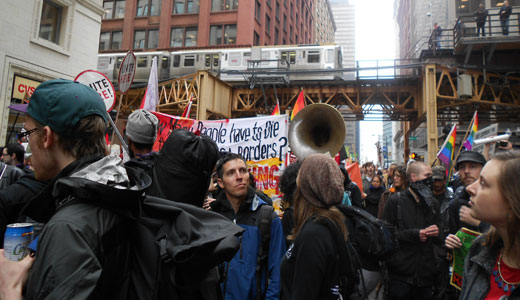
CHICAGO – A rapidly spreading toxic cloud of hydrofluoric acid fumes from an accident at two oil refineries in Lemont and Channahon, Ill., could kill thousands and sicken millions in the Windy City, says a leading union authority on worker and public safety.
The threat to Chicago and other areas around the country is so great, said Gary Beevers, who runs the United Steelworkers’ sector representing oil refinery workers, that the result would be equivalent to or worse than what happened in Bhopal, India in 1984.
In that disaster, considered the worst industrial disaster in history, as many as 8,000 – 16,000 died and 750,000 or more living in the shantytowns surrounding the plant fell ill under a toxic gas cloud.
The United Steelworkers union released a report on Tuesday as part of a campaign to end the use of hydrofluoric acid in U.S. refineries because, in addition to producing severe chemical burns, the chemical can enter the bloodstream and irreparably damage the heart and skeleton. Hydrofluoric acid can travel in a large cloud for 25 miles or even more from the point of a release. If released into the atmosphere it forms a dense vapor cloud that hovers close to the ground, spreading sickness and death as it billows outward from the source.
Beevers issued his warning and discussed it with reporters yesterday at a press event at the Good Jobs Green Jobs conference in Washington. The conference was called by the Blue-Green alliance, a coalition of unions and environmental groups.
Beevers says that a U.S. version of Bhopal is possible in more than just the Chicago area. The formation of deadly hydrofluoric acid clouds are also quite possible, he says, over Philadelphia, the Twin Cities in Minnesota, over Canton, Ohio, over New Orleans, and over Texas City, Texas.
Some of the other dangerous plants cited in the report, in addition to the ones in Illinois, include the St. Paul Park Marathon Oil plant near the Twin Cities, three refineries along the Delaware River near Philadelphia, a Marathon refinery in Canton, Ohio, four different refineries in New Orleans and two in Texas City, Texas.
When the populations of all the threatened areas are added up it comes to 26.1 million at risk nationwide.
There appears to be good reasons to compare the impending danger Americans face to what happened in Bhopal.
Hydrofluoric acid is used in refining gasoline in a process called “alkylation,” to make the fuel burn more cleanly. It is highly toxic, however, and any accidental release can cause severe burns, damage eyes, damaged skin and respiratory problems.
Wind-blown clouds of hydrofluoric acid quickly spread over wide areas, accounting for the high numbers of people at risk in any accidental release.
So far, we’ve been “lucky,” Beevers admits. But “luck” is relative because the six hydrofluoric acid releases that did happen between 2004-12 hospitalized or severely injured seven workers, four with severe burns.
And a release in 1987 sent 900 people to the hospital in Marathon City, Texas, with 50 square blocks having to be evacuated.
At all seven accidents winds were minimal or non-existent. Higher winds would have caused exponential increases in casualties, experts say.
Beevers is concerned about the refusal of oil companies to even admit that there is a problem. He is frustrated, he says, because oil refineries are on the top of the list when it comes to threatening the health of both their own workers and residents of communities surrounding the refineries.
The refineries he cites are 60 years old or even older,
“Their hydrofluoric acid tanks and pipes are aging and some of them leak. And they are chronically understaffed and short of workers who are trained to find and stop such leaks before they spread,” Beevers said.
To compile the report safety experts from inside and outside the USW examined the safety of USW-represented refineries using hydrofluoric acid to refine fuel by reviewing data from OSHA, the U.S. Chemical Safety Board and the industry. Their aim was to see how well these refineries were managing the risk of a hydrofluoric acid release.
At three quarters of the refineries surveyed, a total of 131 hydrofluoric acid-related incidents or near misses had occurred the previous three years. Sixteen sites that reported their most serious events said workers either were or could have been injured, and half said the events caused injuries to people in the community.
More than half of the site survey teams reported that 26 out of 332 safety systems were less than very effective in managing the integrity of the hydrofluoric acid alkylation process.
The study cites alternatives to using hydrofluoric acid and suggests ways existing alkylation units can be made safer. It also says the government could help the process by doing intensive inspections of hydrofluoric acid alkylation units.
“The industry has the technology and expertise and money to eliminate HF alkylation entirely,” said Beevers. “It lacks only the will, and if it cannot find the will voluntarily, it must be forced by government action.”
Asked why oil companies would resist solving the problem, Beevers says it has to do more with power than greed.
“The refiners don’t want anyone,” he said in his Texas drawl, “Least of all a little ol’ union like us telling them what to do.
The only other thing that would force companies to act, Beevers said, would be a huge and fatal accident like the one in Bhopal.
“But we don’t want that,” he said. “The point of our report is to publicize the threat before it happens.”
Photo: A hydrofluoride acid release in Illinois could send a toxic cloud over the Chicago Loop area. Blake Deppe/PW











